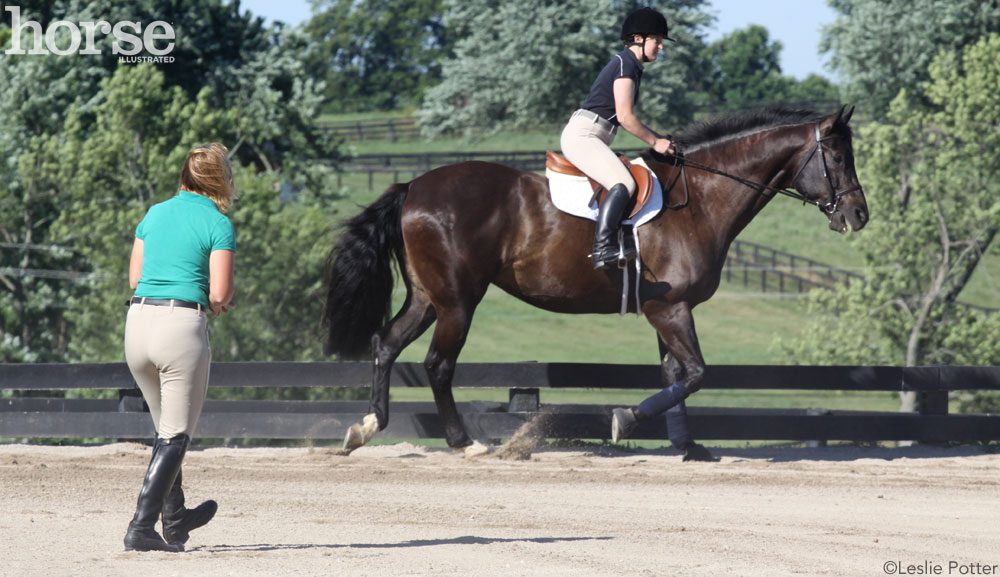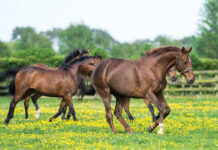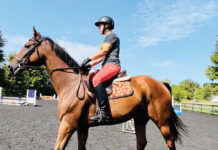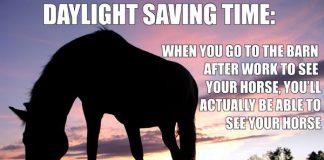Whether we are getting back into riding after years away or preparing for a national competition, the connection we have to our trainer is something akin to a lifeline. We trust them to guide our relationship with a 1,200-pound animal that might spook from hearing the rustle of a bag of chips. For those of us who want to improve on any level, we can’t proceed without a trainer. Read on on how to develop a positive relationship with a trainer.

Trainer Relationship: Teaching Styles
For their part, trainers understand this experience all too well. Do they push us past our comfort zones or keep us in a safe space?
“It depends on the rider,” says Tara Gandomcar-Hieb, trainer and owner of Cottonwood Riding Club in Littleton, Colo. “Trust gets tested all the time. You have to ask yourself, ‘Is this a rider who can pull up her big girl pants, or will she break if I push her?’” As a hunter/jumper trainer for 24 years, Hieb has introduced young children to their first horses and coached riders at top Grand Prix shows. “Honestly, I’ve always believed that trainers should be studying psychology.”
Developing trust is not limited to jumping over fences. Saddle seat trainer Kris Martalock of Bellaire Farms in Milton, Wisc., agrees with Hieb’s belief about studying a rider’s mental agility.
“Being a trainer is more about being a therapist and learning your rider,” she says. “Teaching is more of a mental game than anything. Horses are the easy part.”
This means that the ways we are first introduced to horses matters intensely. Reading the rider’s body language, sensing any apprehension, as well as noting how the horse responds to the rider all fall under the list of training duties. “Once you learn your rider, you learn what kind of horse you can put them on,” says Martalock.
Hieb acknowledges that adults can be harder to train than children. “Kids have less baggage and are more trusting,” she says. “This can be a super scary sport. People fall off, and the rider has to trust the trainer to choose the appropriate horse.
Hieb points out that adults may have a reason for needing a new trainer. “Maybe a bad fall happened, maybe they were doing bigger jumps than they were ready for. Or maybe they just took time off from riding. But they bring baggage with them.”
Trainer Relationship: Varying Confidence
Heather Wallace, writer of both the best-selling book and the blog The Timid Rider believes that a rider’s confidence is directly tied to their trainer.
“The rider-trainer relationship can make or break your confidence in the saddle,” she says. “A trainer that you feel comfortable with who understands how you think is just as important as your partnership with the horse.”
Martalock, however, feels that kids can bring their own baggage. “Some kids want the drama, and sometimes there are entitlement issues,” she says. “I have some kids who cry at just about anything. Even the good riders. One girl, who can ride well, cried when someone else fell off during a lesson. Then she cried when she lost a stirrup. When she had a show this summer, I told her, ‘All I want you to do is not cry.’ She ended up winning her class.”
Whitney Brandhorst of White Blaze Equestrian in Castle Rock, Colo., has spent five years working with both adults and children. “You have to simplify what you’re doing,” she says of working with kids. “I take a slower approach with them until I can add a bit more.”
Big Shows
Working with amateur riders at an advanced level still requires that special balance of psychology and tough-trainer. Every year, Martalock takes many of her top riders to the Kentucky State Fair, the world championship show for American Saddlebreds. The atmosphere at the show buzzes to life with the excitement, but it can also bring high stress for the competitors.
“I tell them that it’s just another show, and that they’re there because they deserve to be in the arena. But the first time riders go, they often let the event take control of them. It’s so big and it gets crazy and loud in there.”
Competitions can spur our anxieties, as many of us know from firsthand experience. Sometimes the arena can feel overwhelming, and we feel that we need to ride harder or at a different pace than normal. This is where our trainer has to calm us down rather than size up the other riders.
“I tell students, ‘Don’t get so nervous that your brain shuts off, and don’t think you have to do more than you need to—just get your gaits and pretend it’s a regular show,’” says Martalock.
We may not realize all of the different hats our trainer wears, from surrogate parent and coach to bad guy and shrink. We love them, and on occasion, hate them. But without their combination of compassion and toughness, we would not have as strong a connection to the sport that sustains us.
This article originally appeared in the February 2019 issue of Horse Illustrated magazine. Click here to subscribe!






